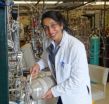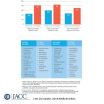(Press-News.org) VIDEO:
To visualize cells' responses to the signals that ultimately lead them to choose a fate, the researchers engineered a protein involved in this response, Smad4, to glow. In response to...
Click here for more information.
When embryonic cells get the signal to specialize the call can come quickly. Or it can arrive slowly. Now, new research from Rockefeller University suggests the speed at which a cell in an embryo receives that signal has an unexpected influence on that cell's fate. Until now, only concentration of the chemical signals was thought to matter in determining if the cell would become, for example, muscle, skin, brain or bone.
"It turns out that if ramped up slowly enough an otherwise potent signal elicits no response from the receiving cells. Meanwhile, a pulsing, on-off signal appears to have a stronger effect than a constant one," says researcher Ali Brivanlou, Robert and Harriet Heilbrunn Professor and head of the Laboratory of Molecular Vertebrate Embryology. This research is the latest collaboration between Brivanlou and Eric Siggia, Viola Ward Brinning and Elbert Calhoun Brinning Professor at Rockefeller's Center for Studies in Physics and Biology.
"Until now, it has not been feasible to test how speed or other temporal dynamics affect a cell's response to a signal. However, by adapting technology that allows for very precise control over these aspects, we found unequivocal evidence that signal level alone does not determine a cell's fate. Its presentation is also extremely important," Siggia says.
Together, the team dubbed their discovery "speed fating." Their work will be published in August in Developmental Cell.
Biologists know a cell determines its location in an embryo and, as a result, its future role, based on chemical cues from its neighbors. About 50 years ago, the developmental biologist Lewis Wolpert proposed that this determination hinges on the concentration of the signal to which a cell is exposed: Go above a certain threshold and you get one fate, below and you get a second. His proposal is known as the French flag model, after a tri-color graph used to represent three cell fates based on those cells' positions with respect to the source of the signal.
Prior work from Brivanlou and Siggia had cast doubt on the sole importance of concentration. Using a common developmental signaling pathway known as TGF-β, the team documented what is known as an adaptive response from cells exposed to TGF-β signaling molecules. This response peaked then declined over time, even though the signaling molecules remained present. (Think of how a constant noise eventually blends into the background.) If concentration was the sole factor responsible for a response, then the response should have continued as long as the signal was present.
To follow up on this work, Benoit Sorre, a former Rockefeller postdoc now at the University of Paris Diderot, adapted a system that makes use of miniaturized networks of pipes, pumps, valves and sample chambers all under computer control. For experiments, he teamed up with Aryeh Warmflash, the postdoc who lead the previous TGF-β work. Together, they worked with mouse cells that have the potential to differentiate into muscle, or cartilage and bone. Progenitor cells like these, which can differentiate into a limited set of tissues, are the offspring of stem cells. In experiments using Sorre's new system, the researchers exposed these progenitor cells to signaling molecules from the TGF-β pathway, and then recorded the cells' responses to see if the signal activated the pathway that leads them to choose a fate.
Sorre and Warmflash started with a continuous signal. As Warmflash's previous work suggested, this finger-stuck-on-the-buzzer approach did not produce a continuous response from the cells. Instead, the response declined. A second set of tests showed a series of brief pulses of signal produced a greater response than one continuous signal.
Gradually increasing the concentration of the signal, however, appeared to have the opposite effect. The researchers ramped up the concentration of the signal over periods as brief as five hours or as long as 40 hours. The longer the period and the slower the rate of increase, the weaker the cells' response. The cells subjected to a 40-hour run barely registered at all.
Based on these experiments, the team formulated a mathematical model to describe how a cell in an embryo may infer its position in relation to the source of the signal. In this way, the research offers a new take on the French flag model: It is still true that the fates of three cells can be mapped out based on their position, but the cells appear to arrive at these fates more rapidly than previously thought, thanks to the adaptive response that takes into account both the level and speed of a signal.
"This finding is another instance of a productive collaboration between biologists and physicists. Neither group, biologists or physicists, could have realized this result working alone," Siggia says.
INFORMATION: END
An embryonic cell's fate is sealed by the speed of a signal
2014-08-04
ELSE PRESS RELEASES FROM THIS DATE:
Scientists uncover combustion mechanism to better predict warming by wildfires
2014-08-04
Scientists have uncovered key attributes of so-called "brown carbon" from wildfires, airborne atmospheric particles that may have influenced current climate models that failed to take the material's warming effects into account. The work was described by a collaborative team of researchers from Los Alamos National Laboratory, Carnegie Mellon University and the University of Montana in the journal Nature Geosciences this week.
"Biomass burning and wildfires emit fine particulates that are toxic to humans and can warm or cool climate. While their toxicity is certain, their ...
Fires not slowing around Yellowknife
2014-08-04
Fires and the resultant smoke that comes from them are both just as widespread and heavy as they were in the month of July. Hundreds of fires dot the landscape and the Northwest Territories Live Fire map shows the extent of the wildfires and hot spots that have been reported. Fire danger around this area of the Northwest Territories remains in either the high or extreme range. On the live fire map, notated detections of new fires number in the dozens. These fires are ones having been detected within the last 24 hours. Residents of Yellowknife were witness to red lightning ...
'I cant figure out how to do this!'
2014-08-04
"Physics summer work, please help!!!," a post on Yahoo! Answers begins. "I cant figure out how to do this anywhere!!! Best answer awarded? Need help immediately!!!!!."
Most of the science and math queries on Yahoo! Answers resemble this one, although some are less hysterical. But they all make people who love science and teaching science cringe. It's not that they think the students are "cheating" by trying to google the answer, but rather that they know students who ask this kind of question are learning nothing and probably confirming a secret conviction that they're ...
Speedier diagnosis of diseases such as cancer likely thanks to new DNA analysis technique
2014-08-04
Researchers from McGill University and the Génome Québec Innovation Centre have achieved a technical breakthrough that should result in speedier diagnosis of cancer and various pre-natal conditions.
The key discovery, which is described online this week in the Proceedings of the National Academy of Sciences (PNAS), lies in a new tool developed by Professors Sabrina Leslie and Walter Reisner of McGill's Physics Department and their collaborator Dr. Rob Sladek of the Génome Québec Innovation Centre. It allows researchers to load long strands of DNA into a tunable nanoscale ...
In defense of mouse models for studying human disorders
2014-08-04
Mouse models of human diseases are essential research tools that are widely used in the medical sciences to increase our understanding of the pathogenesis and pathophysiology of various diseases, and to search for cures. Despite the widespread use of mice as animal models of disease, in 2013, Seok et al. reported that mouse models poorly mimic human inflammatory diseases, such as severe burn injury, sepsis, and acute infection, in terms of gene expression (PNAS 2013, 110(9), 3507-3523), which has been cited more than 400 times since its publication only 18 months ago. Their ...
Sulfur signals in Antarctic snow reveal clues to climate, past and future
2014-08-04
Sulfur signals in the Antarctic snow have revealed the importance of overlooked atmospheric chemistry for understanding climate, past and future.
Eruptions of huge volcanoes, the disruptive weather pattern known as El Niño, and a fire season from hell each left distinctive chemical marks in layers of snow excavated near the South Pole, researchers from the University of California, San Diego and France report in the Proceedings of the National Academy of Sciences the week of August 4.
Sorting out the chemical reactions that must have led to those traces revealed a process, ...
Overtreatment and undertreatment of patients with high blood pressure linked to kidney failure and death
2014-08-04
PASADENA, Calif., August 4, 2014 — The mantra for treatment for high blood pressure has been "the lower, the better," but that goal can potentially put patients at risk of kidney failure or death, according to a Kaiser Permanente study published today in the Journal of the American College of Cardiology.
Researchers examined the electronic health records of nearly 400,000 Kaiser Permanente patients in Southern California who were taking medications to treat high blood pressure from January 2006 through December 2010. They found that:
patients within the range between ...
A polypill strategy to improve global secondary cardiovascular prevention
2014-08-04
WASHINGTON (Aug. 4, 2014) — The polypill, a combination pill taken just once a day that includes key medications for secondary prevention of heart disease, may be an effective low-cost strategy to improve adherence to medication recommendations and reduce costs, according to researchers from Spain and New York, who reviewed research on the polypill.
The review article, A Polypill Strategy to Improve Global Secondary Cardiovascular Prevention, was published online today in the Journal of the American College of Cardiology and will appear in the August 12, 2014 print issue. ...
Protective hinge process enables insulin to bind to cells
2014-08-04
CLEVELAND – August 4, 2014 – Since its landmark discovery in 1922, insulin has improved the health and extended the lives of more than 500 million people worldwide with diabetes mellitus. Yet the question of how this key hormone binds to its target cells in the body’s organs has posed an enduring scientific mystery. A global team of researchers from Cleveland, Australia, Chicago, India and Oregon has made a discovery about insulin and its structure that promises to enable design of new insulin products that will do a better job of regulating the metabolism of patients with ...
Blood-oxytocin levels in normal range in children with autism, study finds
2014-08-04
Autism does not appear to be solely caused by a deficiency of oxytocin, but the hormone's universal ability to boost social function may prove useful in treating a subset of children with the developmental disorder, according to new findings from the Stanford University School of Medicine and Lucile Packard Children's Hospital Stanford.
Low levels of oxytocin, a hormone involved in social functioning, have for years been suspected of causing autism. Prior research seeking a link has produced mixed results. Now, in the largest-ever study to test the purported connection, ...







